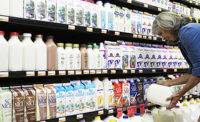Nearly 2 million metric tons of non-dairy creamers were consumed in 2018, totaling a market value worth $2.3 billion. And, fat-free, plant-based and organic creamers claim the largest market share of the group, according to a new research study by Future Market Insights (FMI), Valley Cottage, N.Y.
The consumption of non-dairy creamer is expected to grow at 5% year-over-year in 2019. Key driving factors include:
- Increasing prevalence of lactose-intolerance condition across the globe.
- Growing use of non-dairy creamers as a substitute for milk or cream.
- Non-dairy products’ labeling lacks FDA classification.
“The market for dairy products witnessed a strong competition from non-dairy alternatives in the past decade against the backdrop of increasing population of lactose intolerants. Consumer sentiments for health have led them to distinguish between their purchase of dairy and non-dairy products. In addition, non-dairy brands are leveraging the health consciousness of consumers to communicate the health benefits of non-dairy products. However, without FDA classification, consumers will remain bemused during their purchase, thereby impacting the future market growth,” according to FMI.
Powdered non-dairy creamers remain top-selling category
The study finds that powdered non-dairy creamer consumption remained higher in 2018 and accounted for over 78% of the total non-dairy creamer consumption. While the status-quo is expected to continue in the future, demand for liquid non-dairy creamer is expected to grow at 5% in 2019.
However, the non-dairy creamer market is witnessing a gradual penetration of the “organic” trend. The study finds that consumption of conventional non-dairy creamers equaled nearly 94% of demand in 2018.
The projected rise in the consumption of organic non-dairy creamers can be attributed to consumer sentiments for natural or organic ingredients in the non-dairy products. However, a strong brand image created by non-dairy creamer manufacturers will continue to fuel the consumption of conventional non-dairy creamers in the future.
The study also finds that French vanilla, chocolate, coconut, hazelnut and other flavors collectively accounted for over 55% of the total non-dairy creamer consumption in 2018. Original/unflavored non-dairy creamers accounted for the remaining 45% of the consumption.
Fat-free, non-dairy creamers gaining popularity
The study reveals that light and fat-free non-dairy creamers will collectively account for over two-fifths of the overall non-dairy creamer consumption in 2019. Consumption of the latter will grow over 5% in 2019, implying increasing consumer preference for fat-free food products.
While the popularity of new variants is increasing, consumption of non-dairy creamers with the original nutritional value will continue to account for a considerable share in the market.
The study also shows that consumption of plant-based, non-dairy creamers (almond, coconut, soy, hemp and cashew) will grow at nearly 5% year-over-year in 2019. Vegetable oil-based non-dairy creamers remain a traditional offering, and account for a hefty bulk of the overall consumption.
As per the study, over 45% of all the non-dairy creamers are expected to be consumed in the food and beverage processing industry. Household/retail and Horeca/foodservice collectively accounted for the remaining consumption.
Direct distribution most preferred channel
The study opines that non-dairy creamers will be distributed directly as compared to other sales channels. However, distribution through indirect sales channel, especially hypermarkets/supermarkets and online retail will witness a steady rise in the coming years.
Demand for non-dairy creamers in bulk packaging is expected to remain higher compared to the products available in retail stores in sachets, pouches, bags, canisters, plastic jars and bottles.
The study also shows significant consumption of non-dairy creamers in Europe, followed by North America, wherein they collectively accounted for nearly half the non-dairy creamer consumption.



